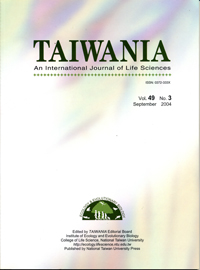Research Paper
Inorganic Carbon Utilization of the Freshwater Red Alga Compsopogon coeruleus (Balbis) Montagne (Compsopogonaceae, Rhodophyta) Evaluated by in situ Measurement of Chlorophyll Fluorescence
Shao-Lun Liu, Liang-Chi Wang and Wei-Lung Wang
Published on: September 2004
Page: 209 - 217
DOI: 10.6165/tai.2004.49(3).209
Abstract
To explore the inorganic carbon utilization of the freshwater red alga Compsopogon coeruleus, photosynthetic rates in response to increasing of bicarbonate concentration, the addition of alkaline HEPES buffer (pH 8.8), acid HEPES buffer (pH 4.0) and the extracellular carbonic anhydrase inhibitor (acetazolamide, AZ), respectively, were examined in situ by using a submersible pulse amplitude modulated (PAM) fluorometer. Among the treatments, adding acid HEPES buffer significantly reduced photosynthetic rates of the alga, while others showed no effect. Accordingly, we concluded that C. coeruleus had less or no inorganic carbon (Ci) limitation in its natural habitat. The alga might have higher affinity for bicarbonate and directly uptake bicarbonate as main Ci source without the aid of extracellular carbonic anhydrase.
中文摘要
本研究使用水中葉綠素螢光分析儀,實地測定在增加無機碳酸鹽濃度、添加鹼性 HEPES 緩衝液 (pH 8.8)、添加酸性HEPES 緩衝液 (pH 4.0) 和胞外碳酸酣酶抑制劑 acetazolamide (AZ) 前後對淡水紅藻 Compsopogon coeruleus 光合作用速率的改變狀況,以期了解C. coeruleus 對外在環境無機碳使用情形。研究結果顯示,添加酸性HEPES 緩衝液 (pH 4.0) 後,C. coeruleus 光合作用速率有顯著下降 (p < 0.05),其他處理則無顯著影響。因此,我們認為C. coeruleus 在其生長棲地並未遭受到碳源不足的限制;在無機碳源的利用中,對重碳酸鹽具有較高的親合力;而重碳酸鹽的吸收方式是採用不需要胞外碳酸酣酶幫助的直接吸收方式。
Keyword: Acetazolamide, Carbonic anhydrase, Fluorometer, Inorganic carbon, HEPES, PAM, Photosynthesis


